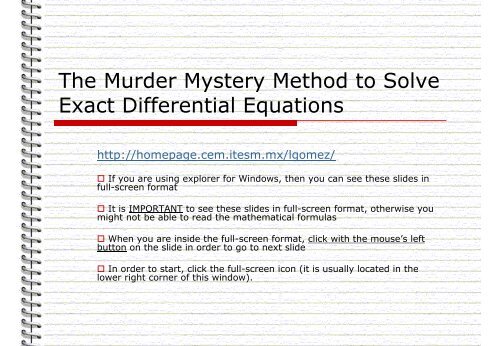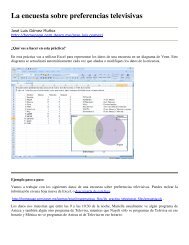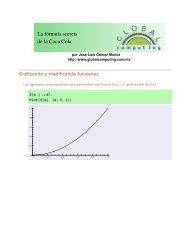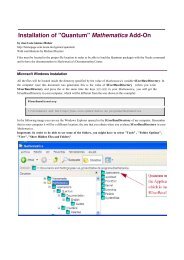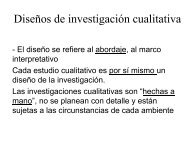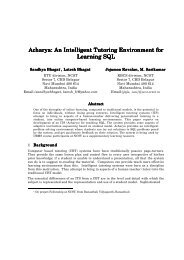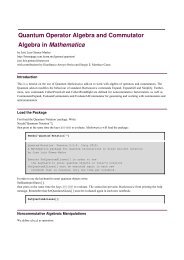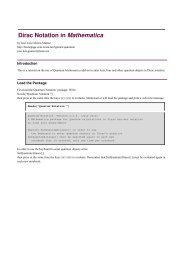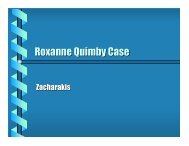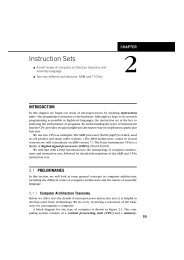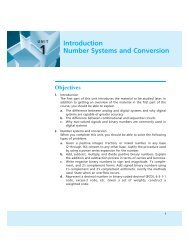The Murder Mystery Method to Solve Exact Differential Equations
The Murder Mystery Method to Solve Exact Differential Equations
The Murder Mystery Method to Solve Exact Differential Equations
Create successful ePaper yourself
Turn your PDF publications into a flip-book with our unique Google optimized e-Paper software.
Creating a <strong>Differential</strong> Equation from aFunction of Two Variables (3)Assume we move in a trajec<strong>to</strong>ry where the function has a constantvalue2 4 2F ( x,y)= 3xy+ x + y =C
Creating a <strong>Differential</strong> Equation from aFunction of Two Variables (4)Assume we move in a trajec<strong>to</strong>ry where the function has a constantvalue2 4 2F ( x,y)= 3xy+ x + y =C<strong>The</strong>n the differential change of the function must be zero:( ) 3y2+ 4x3 dx + ( 6xy+ 2y) dy = 0
Creating a <strong>Differential</strong> Equation from aFunction of Two Variables (5)So we start with a relationship between x and y2 4 2F ( x,y)= 3xy+ x + y =CAnd we obtain a differential equation( ) 3y2+ 4x3 dx + ( 6xy+ 2y) dy = 0
We want <strong>to</strong> do the inverseprocedureWe want <strong>to</strong> be able <strong>to</strong> do the inverse procedure, start with thedifferential equation( ) 3y2+ 4x3 dx + ( 6xy+ 2y) dy = 0And obtain as an answer the relationship between x and y
<strong>The</strong> mystery we have <strong>to</strong> solve<strong>The</strong>refore this is the mystery we have <strong>to</strong> solve:If we have an equation in the form Mdx+Ndy=0; is there afunction F(x,y) such that its differential change is Mdx+Ndy?•If the answer is YES, then the solution of the differential equationis the relationship F(x,y)=C (the equation is called “exact”)•If the answer is NO, then we have <strong>to</strong> use another method <strong>to</strong>solve the differential equation (the equation is called “nonexact”)
You are the Detective! A crime has been committed by theunknown murderer F; you are thedetective, and your job is <strong>to</strong> find theidentity of F by interrogating thewitnesses
<strong>The</strong> murderer F and the witnessesM and N<strong>The</strong> murderer FWitness MWitness N
Interrogate witnessesWitness M:“He was wearinggreen jacket and redpants”Witness N:“He was wearing redpants and brownshoes”
If clues are consistent, then you know what themurderer F was wearingWitness M:“He was wearinggreen jacket and redpants”Witness N:“He was wearing redpants and brownshoes”Clues are consistent,you know what themurderer F waswearing
If clues are not consistent, then you do not knowwhat the murderer F was wearingWitness M:“He was wearinggreen jacket andyellow pants”Witness N:“He was wearingviolet pants andbrown shoes”Clues are NOT consistent: In this case you do not trust the witnessesand you do not have your murderer
<strong>Murder</strong> <strong>Mystery</strong> <strong>Method</strong> Applied <strong>to</strong> Identifyand <strong>Solve</strong> <strong>Exact</strong> <strong>Differential</strong> <strong>Equations</strong> Witnesses M and N are in thedifferential equation: Mdx+Ndy=0 To interrogate them is <strong>to</strong> integratethem Clues that have both x and y musthave been seen by the two witnesses,otherwise, they are not consistentand there is no murderer F (maybe itwas a suicide?).
Example 1 <strong>Solve</strong>: (3y 2 +4x 3 )dx+(6xy+2y)dy=0
Example 1: Interrogation(Integration) <strong>Solve</strong>: (3y 2 +4x 3 )dx+(6xy+2y)dy=0Witness M: Witness N:∫2 32 4( 3y + 4x) dx = 3xy+ x( xy + 2y)∫26 dy = 3xy+ y2
Example 1: Check consistency <strong>Solve</strong>: (3y 2 +4x 3 )dx+(6xy+2y)dy=0Witness M: Witness N:∫2 32 4( 3y + 4x) dx = 3xy+ x( xy + 2y)∫26 dy = 3xy+ y<strong>The</strong> clue that contains the two variables (3xy 2 ) was seen by the twowitnesses: <strong>The</strong>refore we do trust them and we have our murderer (thefunction whose differential is the left side of the equation):F +2 4 2( x,y)= 3xy+ x y2
Example 1: Final Solution <strong>Solve</strong>: (3y 2 +4x 3 )dx+(6xy+2y)dy=0Witness M: Witness N:∫2 32 4( 3y + 4x) dx = 3xy+ x( xy + 2y)∫26 dy = 3xy+ y<strong>The</strong> clue that contains the two variables (3xy 2 ) was seen by the twowitnesses: <strong>The</strong>refore we do trust them and we have our murderer (thefunction whose differential is the left side of the equation):F +2 4 2( x,y)= 3xy+ x y<strong>The</strong> implicit solution of the differential equation is22 4 23xy+ x + y =C
Example 2 <strong>Solve</strong>: (y+x)dx+(y)dy=0
Example 2: Interrogate (Integrate) <strong>Solve</strong>: (y+x)dx+(y)dy=0Witness M: Witness N:∫2x( y + x) dx = xy +2( y)2y∫ dy = 2
Example 2: Check consistency <strong>Solve</strong>: (y+x)dx+(y)dy=0Witness M: Witness N:∫2x( y + x) dx = xy +2( y)2y∫ dy = 2<strong>The</strong> clue that contains the two variables (xy) was seen only by one of thetwo witnesses: <strong>The</strong>refore we do not trust them, and we do not have ourmurderer
Example 2: Final Solution <strong>Solve</strong>: (y+x)dx+(y)dy=0Witness M: Witness N:∫2x( y + x) dx = xy +2( y)2y∫ dy = 2<strong>The</strong> clue that contains the two variables (xy) was seen only by one of thetwo witnesses: <strong>The</strong>refore we do not trust them, and we do not have ourmurdererThis equation is Nonexact, it has <strong>to</strong> be solved by anothermethod
Referencehttp://homepage.cem.itesm.mx/lgomez/ This document is based on the work by TevianDray and Corinne A Manogue: Tevian Dray and Corinne A Manogue, <strong>The</strong>murder mystery method for determiningwhether a vec<strong>to</strong>r field is conservative; <strong>The</strong>College Mathematics Journal; May 2003; 34,3; Academic Research Library; pages 228-231


